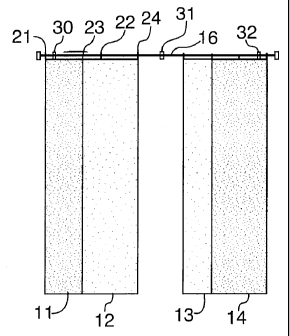Some of the information on this Web page has been provided by external sources. The Government of Canada is not responsible for the accuracy, reliability or currency of the information supplied by external sources. Users wishing to rely upon this information should consult directly with the source of the information. Content provided by external sources is not subject to official languages, privacy and accessibility requirements.
Any discrepancies in the text and image of the Claims and Abstract are due to differing posting times. Text of the Claims and Abstract are posted:
| (12) Patent: | (11) CA 2485364 |
|---|---|
| (54) English Title: | CURTAIN SUSPENSION DEVICE AND A METHOD OF SUSPENDING CURTAINS |
| (54) French Title: | DISPOSITIF DE SUSPENSION DE RIDEAUX ET PROCEDE DE SUSPENSION DE RIDEAUX |
| Status: | Deemed expired |
| (51) International Patent Classification (IPC): |
|
|---|---|
| (72) Inventors : |
|
| (73) Owners : |
|
| (71) Applicants : |
|
| (74) Agent: | RIDOUT & MAYBEE LLP |
| (74) Associate agent: | |
| (45) Issued: | 2011-03-22 |
| (86) PCT Filing Date: | 2003-05-20 |
| (87) Open to Public Inspection: | 2003-11-27 |
| Examination requested: | 2008-05-01 |
| Availability of licence: | N/A |
| (25) Language of filing: | English |
| Patent Cooperation Treaty (PCT): | Yes |
|---|---|
| (86) PCT Filing Number: | PCT/SE2003/000813 |
| (87) International Publication Number: | WO2003/096852 |
| (85) National Entry: | 2004-11-05 |
| (30) Application Priority Data: | |||||||||
|---|---|---|---|---|---|---|---|---|---|
|
A curtain suspension device for hanging curtains flatly (for hanging panel
curtains) comprises a main rod (16) arranged to a wall and at least two
elongate shorter rods (15) with open hooks (17, 26) at both ends. The short
rods are adapted to be hung on the main rod and are adapted to carry a flat
hanging curtain each. The brackets for the main rod clamp the rod and leave
the upper surface of the rod free as a sliding surface for the hooks so that
the hooks can pass the brackets.
L'invention concerne un dispositif de suspension de rideaux permettant de suspendre des rideaux à plat, permettant de suspendre des rideaux sous forme de panneaux, comprenant une tringle principale (16) disposée de manière à être fixée à une paroi et au moins deux tringles plus courtes allongées (15) présentant des crochets ouverts (17, 26) au niveau des deux extrémités. Les tringles courtes sont conçues pour être suspendues sur la tringle principale et pour supporter chacune un rideau plat. Les supports pour la tringle principale serrent la tringle et laissent la surface supérieure de la tringle libre pour qu'elle serve de surface de glissement des crochets permettant le passage des supports.
Note: Claims are shown in the official language in which they were submitted.
Note: Descriptions are shown in the official language in which they were submitted.

For a clearer understanding of the status of the application/patent presented on this page, the site Disclaimer , as well as the definitions for Patent , Administrative Status , Maintenance Fee and Payment History should be consulted.
| Title | Date |
|---|---|
| Forecasted Issue Date | 2011-03-22 |
| (86) PCT Filing Date | 2003-05-20 |
| (87) PCT Publication Date | 2003-11-27 |
| (85) National Entry | 2004-11-05 |
| Examination Requested | 2008-05-01 |
| (45) Issued | 2011-03-22 |
| Deemed Expired | 2013-05-21 |
There is no abandonment history.
| Fee Type | Anniversary Year | Due Date | Amount Paid | Paid Date |
|---|---|---|---|---|
| Application Fee | $400.00 | 2004-11-05 | ||
| Maintenance Fee - Application - New Act | 2 | 2005-05-20 | $100.00 | 2005-02-08 |
| Registration of a document - section 124 | $100.00 | 2005-03-16 | ||
| Maintenance Fee - Application - New Act | 3 | 2006-05-23 | $100.00 | 2006-02-06 |
| Maintenance Fee - Application - New Act | 4 | 2007-05-22 | $100.00 | 2007-01-31 |
| Maintenance Fee - Application - New Act | 5 | 2008-05-20 | $200.00 | 2008-02-04 |
| Request for Examination | $800.00 | 2008-05-01 | ||
| Maintenance Fee - Application - New Act | 6 | 2009-05-20 | $200.00 | 2009-02-11 |
| Maintenance Fee - Application - New Act | 7 | 2010-05-20 | $200.00 | 2010-03-26 |
| Final Fee | $300.00 | 2011-01-04 | ||
| Maintenance Fee - Patent - New Act | 8 | 2011-05-20 | $200.00 | 2011-04-04 |
Note: Records showing the ownership history in alphabetical order.
| Current Owners on Record |
|---|
| HASTA IP HOLDING AB |
| Past Owners on Record |
|---|
| SCHOERLING, STEFAN |